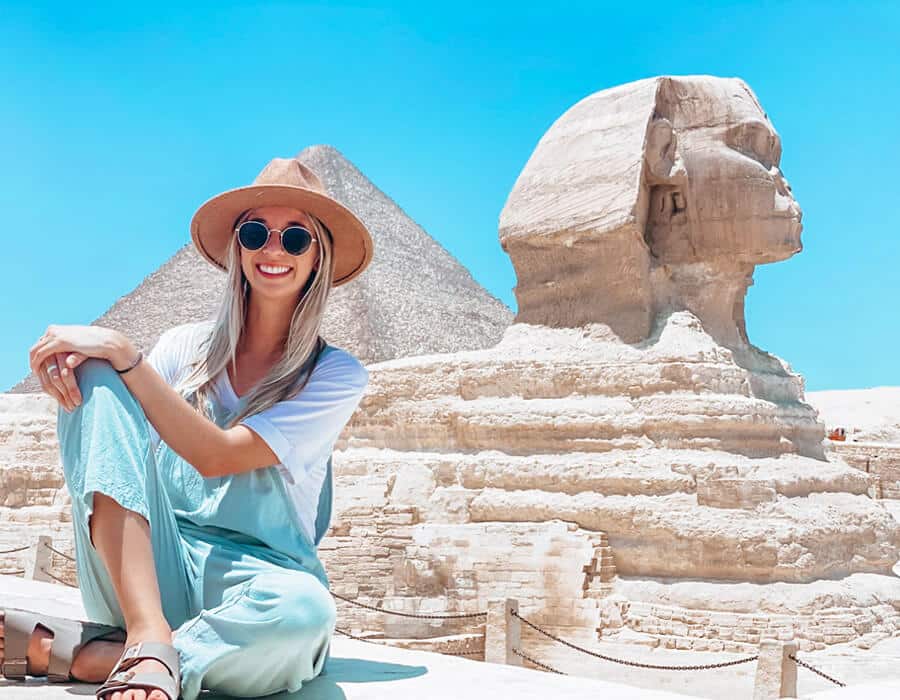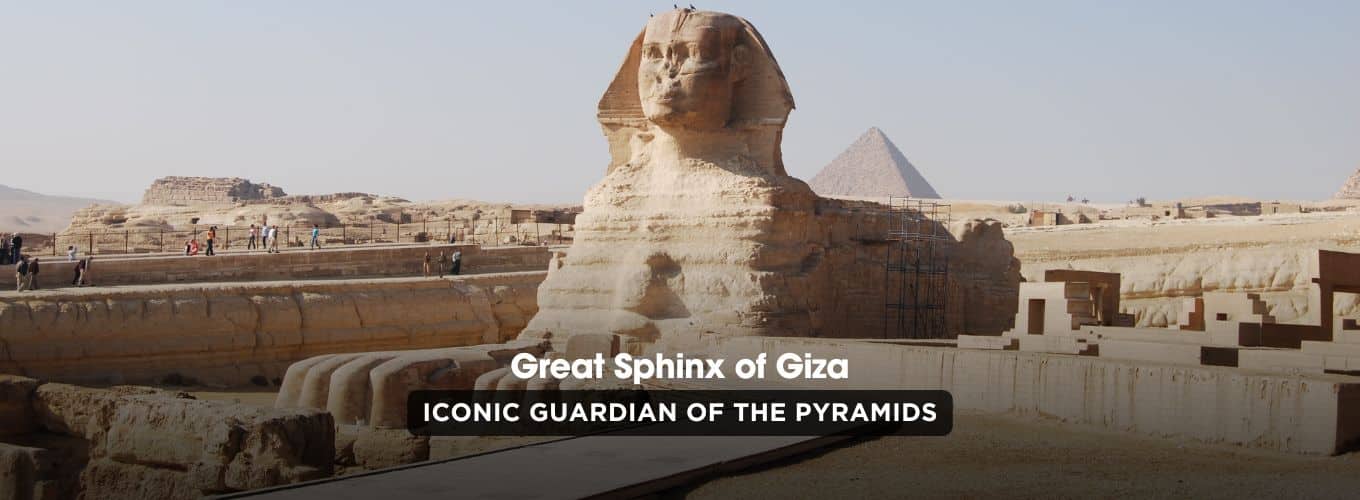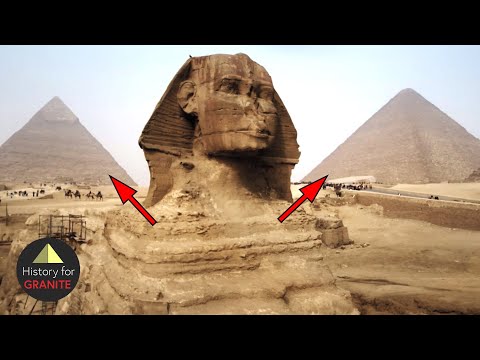The Great Sphinx of Giza stands tall on the west bank of the Nile in Egypt. It’s a huge limestone statue that has amazed people for thousands of years. But what secrets does it hold? What made it, and why does it still fascinate us today?
This statue is one of the most famous symbols of ancient Egypt. It looks straight from west to east. It shows a mythical creature with a human head and a lion’s body. This statue shows the skill and creativity of the ancient Egyptians.
Key Takeaways
- The Great Sphinx of Giza is the oldest known monumental sculpture in Egypt, dating back to around 2500 BC during the Old Kingdom.
- Standing over 65 feet tall and measuring approximately 240 feet in length, the Sphinx is one of the world’s largest and most iconic ancient monuments.
- Archaeological evidence suggests the Sphinx was created during the reign of Pharaoh Khafre, the builder of the Second Pyramid at Giza.
- The Sphinx has faced periods of neglect and restoration, with its nose and other features being damaged over the centuries.
- The Sphinx is associated with the solar deity Hor-em-akhet and played a significant role in the Giza Necropolis complex and ancient Egyptian religious beliefs.
Unveiling the Majestic Great Sphinx of Giza
The Limestone statue of the Great Sphinx of Giza is an archaeological wonder. It amazes visitors with its huge size and iconic features. Built around 2500 BC during Pharaoh Khafre’s rule, it shows the amazing skills of ancient Egyptians.
The Sphinx is 73 meters (240 feet) long from front to back. It is 20 meters (66 feet) tall from the ground to its head. Its big body and the headdress on its head show its royal look. Even after all these years, the Sphinx’s face still looks powerful and important.
Colossal Dimensions and Iconic Features
The Great Sphinx is one of the biggest sculptures ever made. Its huge size shows the greatness of ancient Egyptian culture. The Sphinx wears a special headdress and has a carved cobra on its forehead. These details show its royal status.
|
Measurement |
Dimension |
|
Length |
73 meters (240 feet) |
|
Height |
20 meters (66 feet) |
|
Width |
19 meters (62 feet) |
The Great Sphinx of Giza still amazes and inspires people everywhere. It shows the lasting impact of ancient Egyptian culture and their amazing engineering skills.
Ancient Origins: The Mystery of the Sphinx’s Creation
The Great Sphinx of Giza is a famous and mysterious statue from ancient Egypt. Experts think it was made from the limestone of the Giza Plateau during the Old Kingdom. This was during the time of the fourth-dynasty pharaoh Khafre. The Sphinx’s story is full of secrets, but it was likely a key part of Khafre’s big projects at Giza.
The limestone for the Sphinx probably came from the same place it stands. It was used for the pyramids and other buildings too. It might have taken a team of about 100 workers 3 years to carve this huge statue from one big piece of limestone.
The Sphinx temple next to the statue was also made from limestone taken from the Sphinx. This shows how closely the Sphinx and the temple were linked when they were built. This fact adds to the Sphinx’s mystery and draws in researchers and fans.
|
Fact |
Detail |
|
Age of the Great Sphinx |
Approximately 2603-2578 B.C., corresponding with the reign of Pharaoh Khafre |
|
Construction Timeline |
Estimated 100 workers over 3 years to carve out of a single mass of limestone |
|
Sphinx Temple Construction |
Built using limestone blocks chipped off from the Great Sphinx |
|
Rediscovery |
The Sphinx was buried up to its shoulders in sand until the early 1800s |
|
Restoration Efforts |
Ongoing since the mid-1900s due to erosion caused by wind, humidity, and pollution |
The Great Sphinx of Giza still amazes scholars and visitors with its ancient story and secrets. It’s a huge statue that shows the skill and culture of the Old Kingdom pharaohs.
The Great Sphinx of Giza: A Guardian for the Pyramids

The Giza Necropolis was a sacred place in ancient Egypt. It was home to the famous Great Sphinx. This creature was between the big pyramids of Khufu and Khafre. The Sphinx was seen as a kind guardian for the kings and Egypt.
Symbolic Meaning and Cultural Significance
The Egyptian Sphinx was not like the scary monsters of Greek stories. It was a symbol of royal power, strength, and defense against darkness. It was thought to be Ra-Horakhty, a sun god form. The Sphinx was seen to keep the temple doors safe.
Over time, the Sphinx’s symbolic meaning and cultural significance changed. This shows how the Egyptians’ views on this huge statue changed.
In the Eighteenth Dynasty, the Sphinx was said to talk to Thutmose IV, helping him become king. During Chephren’s rule, more Sphinxes appeared. This made the Sphinx even more linked to royal power and divine protection.
The Great Sphinx of Giza still amazes people from all over the world. It shows the cultural significance and symbolic meaning it had for the ancient Egyptians. Now, it’s a top spot for tourists in the Giza Necropolis. It’s seen as a true guardian for the pyramids and a symbol of Egypt’s rich history.
Rediscovering the Sphinx: Excavations and Restorations
The Great Sphinx of Giza is a famous ancient Egyptian monument. It was forgotten and then rediscovered over the years. People worked hard to bring it back to life after it was buried by sand.
Thutmose IV’s Dream Stele and the Sphinx’s Revival
Back in 1400 BC, during Thutmose IV’s rule, the Sphinx was first tried to be uncovered. Thutmose IV led a team that found the Sphinx’s front paws. He put up a stone slab called the Dream Stele to celebrate this.
This slab linked the Sphinx to the sun god Hor-em-akhet and the pharaoh Khafre. Ramesses II might have done more work on the Sphinx later. His efforts helped make the Sphinx famous again in the ancient world.
|
Excavation Timeline |
Significant Events |
|
c. 1400 BC |
Thutmose IV excavates the Sphinx’s front paws and erects the Dream Stele |
|
Uncertain |
Ramesses II may have conducted a second excavation of the Sphinx |
|
1st century AD |
The Sphinx is cleared of sand in honor of Emperor Nero and the Governor of Egypt, Tiberius Claudius Balbilus |
|
166 AD |
Restoration of the retaining walls surrounding the Sphinx is completed |
These Excavations and Restorations were key in bringing back the Sphinx. They helped keep its story alive as one of the most amazing ancient Egyptian sights.
The Enigmatic Face: Theories on the Sphinx’s Identity
The Great Sphinx of Giza is a mystery. Many think it was made for Khafre, a pharaoh from the fourth dynasty. He built many things at Giza.
But, some believe it could be for Khufu, Khafre’s dad. They say this because the Sphinx looks a bit like statues of Khufu. Yet, we can’t be sure because there’s no clear proof.
The Sphinx was placed carefully in Khafre’s complex. This shows it was likely made for Khafre. Most experts agree it was for him, but we still don’t know for sure.
|
Theories on the Sphinx’s Identity |
Proponents |
Evidence |
|
Khafre |
Most Egyptologists |
Sphinx’s strategic placement within Khafre’s complex |
|
Khufu |
Some scholars |
Facial similarities between Sphinx and Khufu statues |
|
Another Pharaoh |
Minority view |
No definitive inscriptions found |
“The true identity of this iconic figure remains an enduring Sphinx’s identity.”
The Great Sphinx of Giza Through the Ages
For over 4,500 years, the Great Sphinx of Giza has amazed people all over the world. It has left a big mark on art, culture, and tourism. This huge statue is 66 feet tall and 241 feet long. It was made in the 26th and 25th centuries B.C.
Legacy and Impact on Art, Culture, and Tourism
In ancient times, the Sphinx was linked with many gods. It was part of sacred places, showing its deep cultural importance. When the Greco-Roman period came, the Sphinx became a big draw for visitors. Emperors and scholars came to see it because they were so curious.
Now, the Sphinx’s image is seen in places all over the world. It’s one of the most known symbols of ancient Egypt. Today, it’s a top spot for travelers. Adults pay 80 Egyptian pounds ($9) and students pay 40 Egyptian pounds (less than $5).
Visitors need to be somewhat fit to see the Sphinx and its area. Parking is free at the entrance. But, cars inside the site cost 5 Egyptian pounds (less than $1) per car.
“The Great Sphinx of Giza has been a symbol of ancient Egypt’s enduring legacy, inspiring artists, captivating tourists, and leaving an indelible mark on the world’s cultural heritage.”
The Great Sphinx of Giza was built with simple tools like chisels and hammers. It’s still being looked after today. This shows the skill and smart thinking of ancient Egyptian people.
Exploring the Sphinx Temple and Surrounding Complex
Across from the Great Sphinx is a temple that was built at the same time. It was never finished but was still used for sacred purposes. It became a key part of the Sphinx complex in the Giza Necropolis.
Archaeologists found the temple’s limestone blocks and its beautiful alabaster floor. The design shows it was meant to face the sun. The main courtyard might symbolize the day’s 24 hours. It was closely linked to Khafre’s Valley Temple and the high temple, making a unified funerary complex.
The Sphinx Temple looks a lot like other buildings linked to Pharaoh Khafre. This shows a big plan that connected the Sphinx complex. Everything was centered on the huge Sphinx.
Studies found that the temple’s limestone came from the ditch around the Great Sphinx. This shows how closely the temple and the Sphinx were connected.
Workers found a big settlement, called the “Lost City,” near the Sphinx. It was as big as ten football fields and was there during Khafre’s time. Near it was a cemetery with about 600 graves. These finds tell us about the people who helped build this ancient wonder.
|
Key Facts about the Sphinx Temple and Surrounding Complex |
|
Conclusion: Preserving the Great Sphinx of Giza
The Great Sphinx of Giza is a symbol of ancient Egypt’s greatness. It has faced many challenges over the years. Efforts to protect it are ongoing.
This ancient wonder is a UNESCO World Heritage Site. It inspires people all over the world. We must keep it safe for the future.
Preserving the Sphinx is key to honoring ancient Egyptian achievements. Conservation efforts aim to fight weather damage and human harm. By protecting it, we keep its story alive for others to learn from.
Uncovering the Sphinx’s secrets makes us want to protect it even more. With research, restoration, and education, we can keep it for generations to come. It will continue to amaze and inspire everyone who sees it.
Read our related articles:

